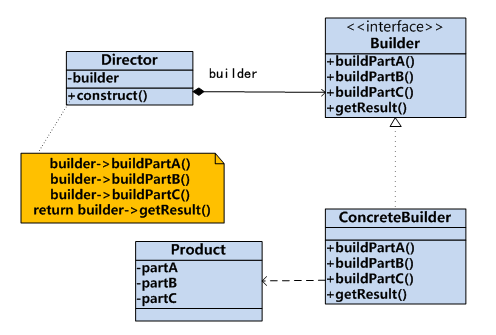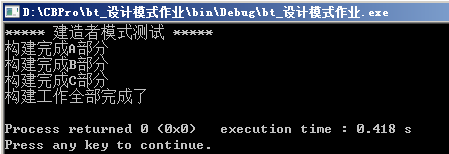模式动机:一个对象由若干部件组成,而组合这些部件的过程比较复杂,因此可以把这个组合工作交给建造者来完成,建造这返回给客户的是一个组装好的对象。
模式定义(Builder Pattern):将一个复杂对象的构建与表示分离开来,使得同样的构建过程可以创建不同的表示形式。
模式结构图:

其中包含抽象建造者Builder、具体建造者ConcreteBuilder、指挥者Director、产品Product。该模式中引入了Director,负责控制产品的生产及其与用户的隔离工作。Director针对抽象建造者Builder编程,客户只要知道具体建造者ConcreteBuilder的类型就能得到一个完整的产品。
模式代码:
bt_建造者模式.h:
1 #ifndef BP_H 2 #define BP_H 3 4 #include <iostream> 5 6 using namespace std; 7 8 /* 9 产品类 10 */ 11 class Product 12 { 13 public: 14 const string& getA() const{ return partA; } 15 void setA(const string& a){ partA = a; } 16 const string& getB() const{ return partB; } 17 void setB(const string& b){ partB = b; } 18 const string& getC() const{ return partC; } 19 void setC(const string& c){ partC = c; } 20 21 private: 22 string partA; 23 string partB; 24 string partC; 25 }; 26 27 /* 28 抽象建造者类 29 */ 30 class Builder 31 { 32 public: 33 virtual ~Builder(){ }; 34 virtual void buildPartA() = 0; 35 virtual void buildPartB() = 0; 36 virtual void buildPartC() = 0; 37 virtual Product* getResult() = 0; 38 }; 39 40 /* 41 具体建造者类 42 */ 43 class ConcreteBuilder : public Builder 44 { 45 public: 46 ConcreteBuilder() 47 { 48 product = new Product; // 具体工厂new一个Product对象,这个工作也可以在抽象工厂中完成 49 } 50 51 virtual void buildPartA() 52 { 53 product->setA("AAA"); 54 cout << "构建完成A部分" << endl; 55 } 56 virtual void buildPartB() 57 { 58 product->setB("BBB"); 59 cout << "构建完成B部分" << endl; 60 } 61 virtual void buildPartC() 62 { 63 product->setC("CCC"); 64 cout << "构建完成C部分" << endl; 65 } 66 virtual Product* getResult() 67 { 68 cout << "构建工作全部完成了" << endl; 69 return product; 70 } 71 72 private: 73 Product* product; 74 }; 75 76 /* 77 指挥者类 78 */ 79 class Director 80 { 81 public: 82 Director(Builder* builder) 83 { 84 this->builder = builder; 85 } 86 87 Product* construct() 88 { 89 builder->buildPartA(); 90 builder->buildPartB(); 91 builder->buildPartC(); 92 return builder->getResult(); 93 } 94 95 private: 96 Builder* builder; 97 }; 98 99 #endif // BP_H
bt_建造者模式.cpp:
1 #include "bt_建造者模式.h" 2 #include <iostream> 3 4 using namespace std; 5 6 int main() 7 {
cout << "***** 建造者模式测试 *****" << endl; 8 Builder* builder = new ConcreteBuilder; 9 Director* director = new Director(builder); 10 Product* product = director->construct(); 11 12 delete product; 13 delete director; 14 delete builder; 15 16 return 0; 17 }

模式优缺点:使用不同的具体建造者,用户可以得到不同的具体对象;增加新的建造者无需修改抽象类即可更改建造方式,因此,对于产品内部组成部分不变的情况下,可以很容易实现花样建造,符合“开闭原则”; 但是如果产品内部发生变化,那么就必须修改建造者。





















 120
120











 被折叠的 条评论
为什么被折叠?
被折叠的 条评论
为什么被折叠?








